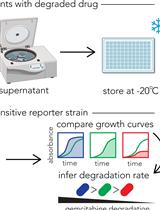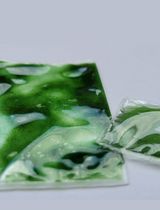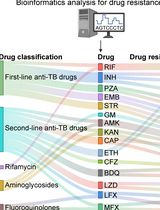- EN - English
- CN - 中文
Construction and Validation of A Low-cost, Small-scale, Multiplex Continuous Culturing System for Microorganisms
低成本、小规模、复合微生物连续培养系统的构建与验证
发布: 2020年11月05日第10卷第21期 DOI: 10.21769/BioProtoc.3813 浏览次数: 3970
评审: Darrell CockburnSimab KanwalAnonymous reviewer(s)
Abstract
This protocol details the construction of a simple, low-cost, small-scale, multiplex chemostat system designed for the continuous cultivation of microorganisms in suspension (i.e., bacteria, yeast, microalgae). The continuous culture device can operate at a working volume of 25 ml and allows the run of 8 chemostats in parallel by a single person. It provides a platform for parallel, long-term studies of evolution and adaptation of microorganisms under the stress of antimicrobial agents and/or toxic pollutants. The system complies with the varied needs of researchers for an accessible, highly-throughput and reliable tool that is nevertheless easy to construct, use and operate, and not demanding of space, materials, medium supply and workload. Here, we also validate the use of this system to generate de novo resistance towards a novel antimicrobial and a commonly used antibiotic in an antimicrobial-sensitive model organism. We believe that this "Do It Yourself" (DIY) system may constitute a useful tool to address the global problem of antibiotic resistance and to develop non-antibiotic based therapies.
Keywords: Continuous culturing (连续培养)Background
Adaptive laboratory evolution experiments provide a powerful tool for readily-replicated, precisely-controlled, long-term, real-time study of evolutionary paths to antibiotic resistance that needs to be considered for the development of sustainable new antimicrobial therapies. The simplest protocol for an experimental evolution is passaging cells in batch cultures using the method of serial transfer (Gresham and Dunham, 2014). During the serial passage, the bacterial population is cultured for 24 h covering populations at exponential to stationary phases, followed by transfer of small bacterial inoculum from sub-inhibitory medium to fresh culture medium restarting the entire cycle anew (Jansen et al., 2013). This protocol can be parallelized using microtiter plates and multiplex liquid handling, which enable the simultaneous analysis of hundreds of populations. The long-term selection can also be performed by continuous chemostat culturing techniques. The chemostat protocol implies the maintenance of a bacterial population continuously in exponential phase by regular inflow of fresh media (that may be supplemented with the desired dose of an antimicrobial) and simultaneous outflow of the waste culture.
Jansen and co-authors (2013) stated that each method covers certain situations in the patient and/or clinical environment. They pointed out that serial passage reflects patient-to-patient transfer or spread across tissues within a single patient, where the transmitted inoculum is initially low and can outgrow after the successful invasion. The chemostat would rather represent infection within a single tissue or systemic bacteremia. When the evolving pathogen population in the chemostat is also continuously challenged by a temporal gradient of an antimicrobial, the chemostat system may simulate bacterial evolution in the host environment, in response to antimicrobial treatment. During this adaptive evolution, mutations may arise, and those that are beneficial under the antimicrobial selection pressure will be fixed over time in the population. Cryopreservation of regular samples from different time points will allow the generation of a living fossil record of the evolving population (Jansen et al., 2013; Gresham and Hong, 2015). After the adaptation, understanding what genetic changes confer the resistance is desirable. Therefore, combining the experimental evolution study with whole-genome sequencing of the evolved population, one can study the evolution of antimicrobial resistance in real-time and identify resistance mechanisms to a novel antimicrobial.
Despite the advantages, the chemostat continuous devices have been limited in their utility first of all because of difficulties posed by the construction, operation and maintenance. Aside from these, only very few publications provide relevant detailed instructions. One other drawback with chemostat systems is that they require large amounts of media and are expensive to build or purchase as commercially available options. Additionally, the replication requiring the operation of several chemostats in parallel over extended periods is technically challenging and rather laborious. We have developed a multiplex, low-cost, small-scale continuous culture device that can operate at a working volume of 25 ml and allows the operation of 8 chemostats in parallel by a single person (Figure 1). Herein, we provide a detailed technical information how to build and operate it. Another challenge with continuous culture devices is that for longer experiments their use is often limited by biofilm formation on the culture chamber walls. Our solution to this problem may be simply aseptically transferring the culture to a new polypropylene culture tube to prolong the experiment each time biofilm formation becomes obvious.
Here, we also validate the use of our DIY continuous culture system to generate and study the resistance emergence in bacteria. The drug-sensitive model bacterium is challenged by progressively increasing concentration of a novel antimicrobial/common antibiotic, thus generating drug-resistant mutants and keeping them constantly challenged. This device and method can be used ultimately to forecast antimicrobial treatment outcomes, including the likelihood of resistance, cross-resistance and collateral-sensitivity. We anticipate that this affordable system will become a useful tool to address the resistance and to develop non-antibiotic based therapies capable of bypassing resistance acquisition. Alternatively, we propose its use to assess the adaptative evolution of photosynthetic microorganisms, such as cyanobacteria and microalgae, to extreme environmental changes derived from anthropogenic pollution (i.e., herbicides, heavy metals, petroleum contamination and others).
Materials and Reagents
Aluminum foil, 450 mm × 90 m roll (Sparks Lab Supplies, catalog number: ALF01 )
Antibiotic/antimicrobial of interest, e.g., gentamicin sulfate salt hydrate (Sigma-Aldrich, catalog number: 17849-5G-F )
Antibiotic-free Luria-Bertani (LB) agar plates (see Recipe 1)
Bacterial strain of interest, e.g., Escherichia coli DSM 1103 (DSMZ culture collection)
Centrifuge tubes, polypropylene, autoclavable, conical, 50 ml (Sparks Lab Supplies, catalog number: AB-P10403 )
Cryogenic vials, sterile, 2 ml (Fisher Scientific, FisherbrandTM, catalog number: 11787939 )
Ethanol solution, 70% (Fisher Scientific, Fisher BioReagentsTM, catalog number: 15430665 )
Glycerol, ≥ 99.5% (Sigma-Aldrich, catalog number: G9012-500ML )
Glycerol, 30% (see Recipe 2)
LB broth (Sigma-Aldrich, Lennox, catalog number: L3022-1KG )
LB broth at quarter strength (see Recipe 3)
LB broth with agar (Sigma-Aldrich, Lennox, catalog number: L2897-1KG )
Micropipette tips, 10 µl/200 µl/1,000 µl (Sparks Lab Supplies, catalog number: AB-P10115/AB-P10107/PT011 )
Multiwell plates, U 96-well, polystyrene, sterile (Sparks Lab Supplies, catalog number: G650161 )
Pasteur pipettes, glass, 150 mm/230 mm (Sparks Lab Supplies, catalog number: PP150/PP230 )
Phosphate buffered saline (PBS), 10× concentrate, sterile (Sigma-Aldrich, catalog number: P5493-1L )
PBS, 1× (see Recipe 4)
Syringe, sterile, disposable, 20 ml (Sparks Lab Supplies, Terumo, catalog number: SYR6208 )
Syringe filters, sterile, blue, 0.22 µm, 25 mm (Sparks Lab Supplies, catalog number: FIL6610 )
Equipment
Air pump with 8 outlet chrome manifold, 25 L (Warehouse Aquatics, Blagdon Koi)
Autoclave (Mason Technology, Tuttnauer, LABV-D 3870ELV-D 85L)
Bottle, Duran style, glass, autoclavable, 1 L, 45 mm wide mouth, blue plastic cap (Sparks Lab Supplies, catalog number: BOT5310 )
Bottle, Duran style, glass, autoclavable, 5 L, 45 mm wide mouth, blue plastic cap (Sparks Lab Supplies, catalog number: BOT5314 )
Electric drill with 2 mm, 4 mm and 6 mm bits (Bosch, Hardware store)
Freezer, -80 °C (Haier Biomedical)
Fridge, 4 °C (Kenwood)
Incubator shaker, 37 °C (Mason Technology, New BrunswickTM Innova® 42R, catalog number: M1335-0006 )
Microplate reader (Tecan, SunriseTM)
Multichannel pipettor Lambda Plus 8, 1-10 µl/20-200 µl (Fisher Scientific, CorningTM, catalog number: 11333625/11353625 )
Peristaltic pump, 205S manual drive (Watson-Marlow, catalog number: 026.3001.00U )
205Ca8, 8 channel, 8 roller acetal cassette P/H (Watson-Marlow, catalog number: 023.1201.000 )
Stopper, rubber, red, No. 27, 31 mm top diameter, 27 mm bottom diameter, 32 mm height (VWR, catalog number: 391-2117 )
Tube rack, stainless steel, 10 × 30 mm (Fisher Scientific, Grant InstrumentsTM, catalog number: 15365842 )
Tubing clamps, stainless steel, pinch-cock (Fisher Scientific, BochemTM HOFFMANNTM, catalog number: 11885091 )
Tubing clumps, plastic, autoclavable, mid-range with 15 positions (Fisher Scientific, Bel-ArtTM SP SciencewareTM, catalog number: 11753177 )
Tubing connectors, polypropylene, straight, for 4-7 mm tubing (Fisher Scientific, AzlonTM, catalog number: 10772227 )
Tubing, medium, silicone, translucent, 5 mm inside diameter, 1.5 mm wall thickness (VWR, catalog number: DENE3100508/25 )
Tubing, pump, PVC manifold, 2.79 mm inside diameter, 0.8 mm wall thickness, purple/white (Fisher Scientific, Watson-Marlow, catalog number: 980.0279.000 )
Tubing, small, silicone, translucent, 4 mm inside diameter, 1.5 mm wall thickness (Fisher Scientific, FisherbrandTM, catalog number: 10644182 )
Water bath, unstirred, digital, 22 L (Sparks Lab Supplies, Clifton, catalog number: NE2-22D )
Software
MagellanTM software (Tecan, SunriseTM)
Excel (Microsoft)
Procedure
文章信息
版权信息
© 2020 The Authors; exclusive licensee Bio-protocol LLC.
如何引用
Tonoyan, L., Guihéneuf, F., Friel, R. and O'Flaherty, V. (2020). Construction and Validation of A Low-cost, Small-scale, Multiplex Continuous Culturing System for Microorganisms. Bio-protocol 10(21): e3813. DOI: 10.21769/BioProtoc.3813.
分类
微生物学 > 抗微生物试验 > 抗细菌试验
细胞生物学 > 细胞活力 > 细胞存活
您对这篇实验方法有问题吗?
在此处发布您的问题,我们将邀请本文作者来回答。同时,我们会将您的问题发布到Bio-protocol Exchange,以便寻求社区成员的帮助。
Share
Bluesky
X
Copy link















